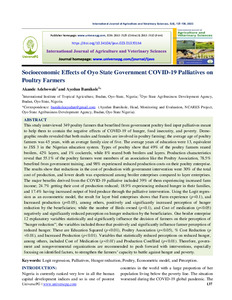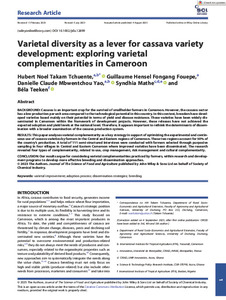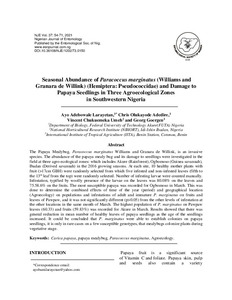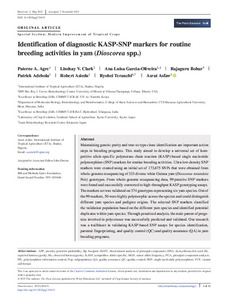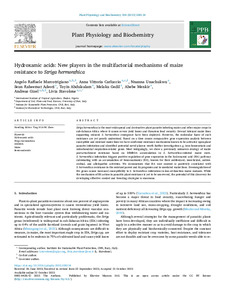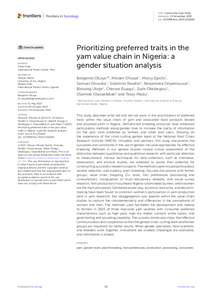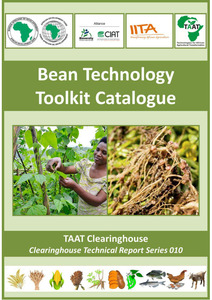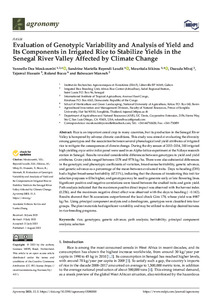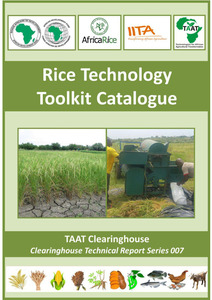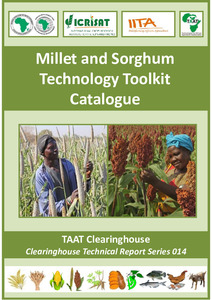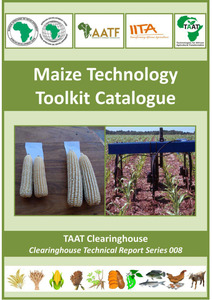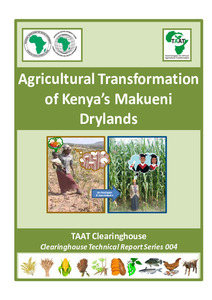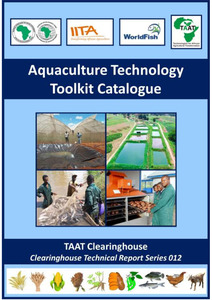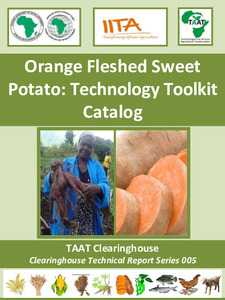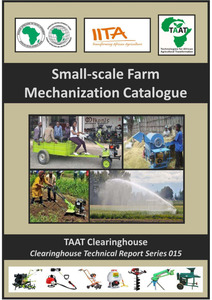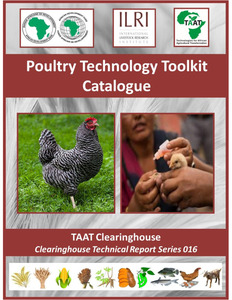Welcome to the International Institute of Tropical Agriculture Research Repository
IITA Bibliography System: Recent submissions
Now showing items 281-300 of 8094
-
Socioeconomic effects of Oyo state government COVID-19 palliatives on poultry farmers
(2023)This study interviewed 349 poultry farmers that benefited from government poultry feed input palliatives meant to help them to contain the negative effects of COVID-19 of hunger, food insecurity, and poverty. Demographic results revealed that both males and females are involved in poultry farming; the average age of poultry farmers was 45 years, with an average family size of five. The average years of education were 13, equivalent to JSS 3 in the Nigerian education system. Types of poultry show ... -
Varietal diversity as a lever for cassava variety development: exploring varietal complementarities in Cameroon
(2023)BACKGROUND: Cassava is an important crop for the survival of smallholder farmers in Cameroon. However, the cassava sector has a low production per unit area compared to the technological potential in this country. In this context, breeders have developed varieties based mainly on their potential in terms of yield and disease resistance. These varieties have been widely disseminated in Cameroon within the framework of development projects. However, these releases have not achieved the expected ... -
Seasonal abundance of Paracoccus marginatus (Williams and Granara de Willink) (Hemiptera: Pseudococcidae) and damage to papaya seedlings in three agroecological zones in Southwestern Nigeria
(2021)The Papaya Mealybug, Paracoccus marginatus Williams and Granara de Willink, is an invasive species. The abundance of the papaya mealy bug and its damage to seedlings were investigated in the field at three agro-ecological zones: which includes Akure (Rainforest), Ogbomoso (Guinea savannah), Ibadan (Derived savannah) in the 2016 growing seasons. At each site, 10 healthy mother plants with fruit (> 17cm GBH) were randomly selected from which five infested and non-infested leaves (fifth to the 13th ... -
Identification of diagnostic KASP-SNP markers for routine breeding activities in yam (Dioscorea spp.)
(2023)Maintaining genetic purity and true-to-type clone identification are important action steps in breeding programs. This study aimed to develop a universal set of kompetitive allele-specific polymerase chain reaction (KASP)-based single nucleotide polymorphism (SNP) markers for routine breeding activities. Ultra-low-density SNP markers were created using an initial set of 173,675 SNPs that were obtained from whole-genome resequencing of 333 diverse white Guinea yam (Dioscorea rotundata Poir) genotypes. ... -
Hydroxamic acids: New players in the multifactorial mechanisms of maize resistance to Striga hermonthica
(2023-11)Striga hermonthica is the most widespread and destructive plant parasite infesting maize and other major crops in sub-Saharan Africa where it causes severe yield losses and threatens food security. Several tolerant maize lines supporting reduced S. hermonthica emergence have been deployed. However, the molecular bases of such resistance are yet poorly understood. Based on a time course comparative gene expression analysis between susceptible and resistant maize lines we have confirmed resistance ... -
Adaptive Research Programme: Technical Report No. 3
(North West Development Authority, Cameroon, 1988) -
Prioritizing preferred traits in the yam value chain in Nigeria: a gender situation analysis
(2023-11-13)This study describes what did and did not work in the prioritization of preferred traits within the value chain of yam and associated food products (boiled and pounded yam) in Nigeria. Demand-led breeding protocols have enhanced participatory methods along gender lines to increase the clarity of information on the yam traits preferred by farmers and other end users. Drawing on the experience of the cross-cutting gender team at the National Root Crops Research Institute (NRCRI), Umudike, and partners, ... -
Bean technology toolkit catalogue: clearinghouse technical report series 010
(Technologies for African Agricultural Transformation, 2021-10) -
Evaluation of genotypic variability and analysis of yield and its components in irrigated rice to stabilize yields in the Senegal river valley affected by climate change
(2023)Rice is an important cereal crop in many countries, but its production in the Senegal River Valley is hampered by adverse climatic conditions. This study was aimed at evaluating the diversity among genotypes and the association between several phenological and yield attributes of irrigated rice to mitigate the consequences of climate change. During the dry season of 2013–2014, 300 irrigated high yielding oryza sativa indica panel were used in an Alpha-lattice experiment at the Ndiaye research ... -
Climate smart agricultural technologies for the Sahel and horn of Africa: Clearinghouse technical report series 009
(Technologies for African Agricultural Transformation, 2021-10) -
Rice technology toolkit catalogue: clearinghouse technical report series 007
(Technologies for African Agricultural Transformation, 2021-05) -
Cassava technology toolkit catalogue: Clearinghouse technical report series 006
(Technologies for African Agricultural Transformation, 2021-03) -
Millet and Sorghum technology toolkit catalogue: Clearinghouse technical report series 014
(Technologies for African Agricultural Transformation, 2022-06)This catalogue describes a suite of technologies related to the modernization of sorghum & millet production in Africa. It is based upon the combined efforts of the Project Platform for Agricultural Solutions (ProPAS), an information internet site, and the Technologies for African Agricultural Transformation, a large collaborative program that is deploying agricultural solutions across the continent. Both activities are based upon the imperative to better connect proven technologies to those who ... -
Maize technology toolkit catalogue: Clearinghouse technical report series 008
(Technologies for African Agricultural Transformation, 2021-05) -
Agricultural transformation of Kenya's Makueni drylands: clearinghouse technical report series 004
(Technologies for African Agricultural Transformation, 2020-01) -
Aquaculture technology toolkit catalogue: clearinghouse technical report series 012
(Technologies for African Agricultural Transformation, 2022-04)This catalogue describes a series of technologies related to the modernization of aquaculture in Africa. It is developed through a collaborative effort from the Technologies for African Agricultural Transformation (TAAT) program from the African Development Bank that seeks to increase stakeholder usage of proven agricultural technology, and its Aquaculture Compact project partners. The compilation is also supported by the Project Platform for Agricultural Solutions (ProPAS), an information portal ... -
Orange fleshed sweet potato; technology toolkit catalog: Clearinghouse technical report series 005
(Technologies for African Agricultural Transformation, 2020-12) -
Small scale farm mechanization catalogue: Clearinghouse technical report series 015
(Technologies for African Agricultural Transformation, 2022-07)Small-scale mechanization is the key to reducing drudgery and increasing productivity among African farmers. For too long farming in Africa is regarded as a path to poverty rather than a profitable agribusiness. This is due in large part for dependency upon tedious hand labor, poor returns to effort and lack of investment into farming systems. A wide range of small-scale equipment is available to improve returns to labor and change this poor image of farming. This equipment include tillers, power ... -
Poultry technology toolkit catalogue: Clearinghouse technical report series 016
(Technologies for African Agricultural Transformation, 2022-08)This catalogue describes a suite of proven poultry technologies that advance increased productivity of animal enterprise in Africa. It was developed through a collaborative effort between the Technologies for African Agricultural Transformation (TAAT) Program of the African Development Bank and its Small Livestock Compact coordinated by the International Livestock Research Institute (ILRI). The compilation was also supported by the Project Platform for Agricultural Solutions (ProPAS), an information ... -
Entrepreneurial and attitudinal determinants for adoption of Climate-smart Agriculture technologies in Uganda
(2023)Climate-Smart Agriculture (CSA) technologies have great potential to minimize climate risks, sequester carbon, improve food security, and achievement of Sustainable Intensification (SI) goals. This makes their adoption a necessity for achieving sustainable agricultural systems. Despite the benefits and all efforts, smallholder farmers in developing countries still have low adoption of CSA technologies. This study explored the determinants of intentions to start and continue adopting CSA technologies. ...

